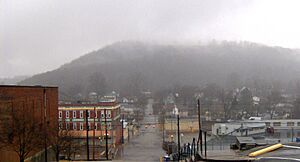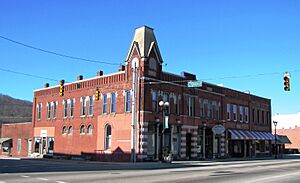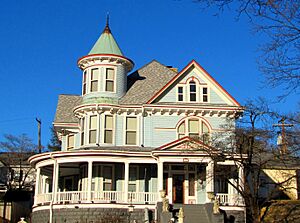Harriman, Tennessee facts for kids
Quick facts for kids
Harriman, Tennessee
|
|
|---|---|
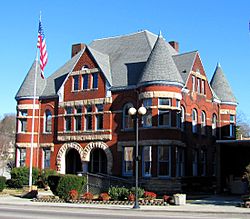
Harriman City Hall
|
|
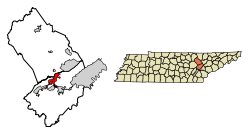
Location of Harriman in Roane County, Tennessee.
|
|
| Country | United States |
| State | Tennessee |
| Counties | Roane, Morgan |
| Incorporated | 1891 |
| Named for | Walter Harriman |
| Area | |
| • Total | 10.69 sq mi (27.70 km2) |
| • Land | 10.50 sq mi (27.19 km2) |
| • Water | 0.20 sq mi (0.50 km2) |
| Elevation | 883 ft (269 m) |
| Population
(2020)
|
|
| • Total | 5,892 |
| • Density | 561.20/sq mi (216.68/km2) |
| Time zone | UTC-5 (Eastern (EST)) |
| • Summer (DST) | UTC-4 (EDT) |
| ZIP code |
37748
|
| Area code(s) | 865 |
| FIPS code | 47-32520 |
| GNIS feature ID | 2403803 |
Harriman is a city mostly in Roane County, Tennessee, with a small part extending into Morgan County. In 2020, about 5,892 people lived there.
Contents
Exploring Harriman's Geography
Harriman is located where the Tennessee Valley meets the Cumberland Plateau. The Plateau, especially its Walden Ridge cliffs, rises hundreds of feet above the city to the west. The Emory River flows into the Tennessee Valley just west of Harriman. It forms a big loop that goes around the oldest part of Harriman.
Important roads run through Harriman. U.S. Route 27, also called Roane Street, goes north and south through the city. Interstate 40 runs east and west through the southern part of the city. Harriman shares its southwestern border with Rockwood. This border is about half a mile south of where US-27 and I-40 meet.
The city's southeastern border is along Pine Ridge, which looks over the Kingston Fossil Plant. Harriman's northern border is close to where US-27 splits off from State Highway 61.
The United States Census Bureau says that Harriman covers about 10.6 square miles (27.4 square kilometers). Most of this area is land, with a small part being water.
Harriman's Population and People
| Historical population | |||
|---|---|---|---|
| Census | Pop. | %± | |
| 1890 | 716 | — | |
| 1900 | 3,442 | 380.7% | |
| 1910 | 3,061 | −11.1% | |
| 1920 | 4,019 | 31.3% | |
| 1930 | 4,588 | 14.2% | |
| 1940 | 5,620 | 22.5% | |
| 1950 | 6,389 | 13.7% | |
| 1960 | 5,931 | −7.2% | |
| 1970 | 8,734 | 47.3% | |
| 1980 | 8,303 | −4.9% | |
| 1990 | 7,119 | −14.3% | |
| 2000 | 6,744 | −5.3% | |
| 2010 | 6,350 | −5.8% | |
| 2020 | 5,892 | −7.2% | |
| 2023 (est.) | 6,171 | −2.8% | |
| Sources: | |||
Harriman is part of the larger Knoxville, Tennessee area, known as the Metropolitan Statistical Area.
Who Lives in Harriman?
| Race | Number | Percentage |
|---|---|---|
| White (non-Hispanic) | 5,014 | 85.1% |
| Black or African American (non-Hispanic) | 352 | 5.97% |
| Native American | 27 | 0.46% |
| Asian | 38 | 0.64% |
| Pacific Islander | 2 | 0.03% |
| Other/Mixed | 344 | 5.84% |
| Hispanic or Latino | 115 | 1.95% |
In 2020, there were 5,892 people living in Harriman. These people lived in 2,567 households, which included 1,408 families.
Harriman's Interesting History
Founding a Special Town
Harriman was started in 1889 as a "Temperance Town." This means it was founded by people who believed that avoiding alcohol was important for a good society. These activists were led by Frederick Gates, a minister and manager from New York. They wanted to create a town that could grow with businesses but avoid the problems often seen in factory towns back then.
In May 1889, Gates and other supporters of this idea formed the East Tennessee Land Company. Over the next few months, the company bought a lot of land around what is now Harriman. This included land from Robert K. Byrd, a colonel and state senator. Early investors in the company included General Clinton B. Fisk, who ran for president in 1888 for the Prohibition Party. He became the company's first president. Other investors included Quaker Oats co-founder Ferdinand Schumacher.
The East Tennessee Land Company planned to buy land, build a town based on their beliefs, and create smaller companies to attract businesses. After a successful land sale in Harriman in 1890, they set up three smaller companies. These included the East Tennessee Mining Company for coal and iron, the Harriman Coal & Iron Railroad Company for railroads, and the Harriman Manufacturing Company to help new industries start.
To show how successful they were and to advertise Harriman, the company built a large brick headquarters. This building, with its four Norman towers, is now Harriman City Hall. By 1892, many factories and businesses had moved to Harriman.
However, the East Tennessee Land Company borrowed a lot of money. In late 1891, it became hard to get money in the U.S., leading to a financial crisis in 1893. The company couldn't pay the interest on its loan and tried to sell more stock, but it didn't work. In November 1893, the company went out of business.
How Harriman Grew
Harriman is named after Walter Harriman, who was a governor of New Hampshire. His son, Walter C. Harriman, was a leader in the East Tennessee Land Company. During the Civil War, Walter Harriman, then a colonel, marched through the area. He camped near the Emory River, where the city would later be built. An older local person told the company directors that Harriman had said this spot would be perfect for a town. Because of this story, they chose the name "Harriman."
The city's location was chosen because it was close to Emory Gap. This was where two important railways met: the Cincinnati Southern Railway and the East Tennessee, Virginia and Georgia Railway. The city was planned on Christmas Day in 1889. It was laid out in a grid pattern that followed the bend of the Emory River at the base of Walden Ridge.
A special block of land was set aside for public buildings, where the city hall, library, and fire department are now. Lots in the higher areas, like Cornstalk Heights, were much larger. It was expected that wealthy people would build their homes there. Areas along the river were for factories and homes for skilled workers.
The first land sale for Harriman happened in February 1890. Over 4,000 people came from all over the country to buy land. Hundreds of lots were sold, bringing in over $600,000. The most expensive lots were along Roane Street and in Cornstalk Heights, selling for over $2,000 each. Lots closer to the river usually sold for less than $500. Soon after, the company created more lots outside the city for workers' homes.
Harriman in the 20th Century
Even though the East Tennessee Land Company failed, Harriman continued to grow slowly. The American Temperance University opened in 1894 in the old company headquarters. In 1929, a stock market crash and a big flood of the Emory River badly hurt the city's businesses.
A paper mill and two hosiery mills (which made socks and stockings) provided most of the jobs in Harriman for the rest of the 20th century. The paper mill, owned by Mead Corporation, and the hosiery companies, Harriman Hosiery and Roane Hosiery, operated into the 1980s.
In the 1940s and 1950s, Harriman got a boost from a lot of car traffic on US-27. This road was a main route connecting the Great Lakes region with Florida before I-75 was built. When Interstate 40 was built through southwestern Harriman, it connected the city more closely with Knoxville. However, it didn't bring as much new industry to the town as leaders had hoped.
Today, Harriman still shows signs of being a "planned community." Its streets are still in their original grid pattern. This is because the company's failure in 1893 "froze" the city's development in its early stages. Many homes, especially in Cornstalk Heights, still show Victorian architecture. Many of these homes have been carefully kept or restored. The city's history with the temperance movement lasted a long time; there wasn't a store selling alcohol in Harriman until 1992.
Education in Harriman
Harriman was home to American Temperance University from 1893 to 1908.
Public schools for students from kindergarten to 12th grade in Harriman are part of the Roane County school system:
- Bowers Elementary - for grades K–5
- Harriman Middle - for grades 6–8
- Harriman High School - for grades 9–12
For higher education, the main campus of Roane State Community College is located just outside Harriman. Also, the Tennessee College of Applied Technology - Harriman is just north of the city.
Harriman's Sports History
The city once had a Minor League Baseball team called the Harriman Boosters. They played in the Appalachian League in 1914.
Famous People from Harriman
- Sharrieffa Barksdale (born 1961), an Olympic hurdler
- Robert K. Byrd (1823–1885), a Union Army colonel and state senator
- Jeremaine Copeland (born 1977), a professional football player and coach
- Dixie Lee (1911–1952), a singer and actress, and the first wife of Bing Crosby
- J. C. Powell (1926–1988), an academic who was once president of Eastern Kentucky University
- Steve Summers, a costume designer and creative director for Dolly Parton
See also
 In Spanish: Harriman (Tennessee) para niños
In Spanish: Harriman (Tennessee) para niños


